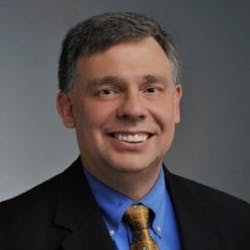Planning for More Reliable Energy Solutions to Natural Disasters One Locale at a Time
In this week’s Industry Perspectives, Clark Wiedetz, microgrid and renewable integration director for Siemens Energy Management, explores local, reliable energy solutions to natural disasters.
Clark Wiedetz, Siemens Energy Management
The ability to island when the end-use client loses power is arguably the most common application for a microgrid. If microgrid controls could also redirect water in the same way that they can redirect thermal and electrical loads, then we have a simple control solution for most natural disasters, especially weather-related. Of course, this is easier said than done.
However, this does lead to the question about the necessary stakeholders to improve the planning for more reliable energy solutions to natural disasters. Utilities are working hard to provide power during these situations – but how can others help? Business resiliency and energy innovation was the topic of Harvard Business Review’s most recent Analytics Services study published in September 2017. According to the study, 87 percent of the respondents indicated that municipal governments and private enterprises should work closely together to assure operational resilience.
City planners, applicable utilities (water, gas and electric), private sector entities and equipment suppliers must get together to discuss a local answer to reliable energy solutions, since this will vary by geographic location based on population, available infrastructure, participants, etc.
Example: small rural city
Let’s say that you are part of a small rural city with a population of 25,000 people with 40% of the population senior citizens, who would have a difficult time traveling away from the disaster. There needs to be a plan to locate these 10,000 seniors during utility outages, in addition to establishing power, water and indoor climate-controlled locations (e.g., schools, colleges, sporting arenas, etc.) that can run on distributed generation for at least a week. For such a scenario, we can plan on using distributed generation assets, storage and advanced microgrid controls as part of the solution.
Larger cities may need to think of themselves as groups of smaller cities in order to simplify the planning process and geographical solutions.
Larger cities may need to think of themselves as groups of smaller cities in order to simplify the planning process and geographical solutions. The City of Pittsburgh is a great example of forging such relationships and taking a leadership role in energy innovation for larger cities. Pittsburgh modeled energy consumption and generation across the region to identify inefficiencies and opportunities to leverage innovations, including microgrids and CHP systems. Armed with that knowledge, city leaders reached out to businesses and other constituents to improve resiliency and efficiency.
In short, public and private entities need to get together to decide on infrastructure and support to plan ahead with local constituents. Utilities do an outstanding job of preparing for disasters, and they initially pay for this extra service when required. We cannot, however, wait for the capital from local constituents before trying to solve these problems. Utilizing investment from the private sector can bridge the timing and allow us to begin work now without a public sector cash flow crunch. Such a concept smoothes out the cash flows by allowing the private sector to own assets and receive payments over the lifetime of the equipment and services.
It is time to huddle up for a public/private approach to the planning process and business structure to prepare for the next storm season.
Clark Wiedetz is microgrid and renewable integration director for Siemens Energy Management.

